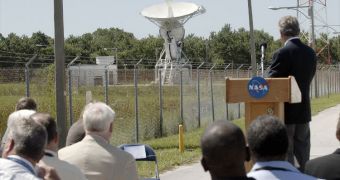On September 1, the American space agency plans to close down the Merritt Island Launch Annex (MILA) tracking and data station permanently. The antenna, located at the NASA Kennedy Space Center (KSC), has been with the Space Shuttle Program (SSP) since its inception.
The radio dish was used by NASA mission controllers to relay signals to and from the space shuttle as the vehicle was soaring above the KSC Launch Pad 39A/B complexes. Now that the SSP is concluded, and all shuttles grounded, there is no reason for the installation to remain operational.
MILA was parked for the last time a short while ago, in anticipation of its full shutdown within a month. The data station houses two steerable. 30-foot dish antennas, of which just one will be retired.
The relay station is being closed down after no less than 45 years of active service to the United States and its space program. On Thursday, July 28, as part of a ceremony to mark the event, the antenna was reoriented from its horizontal to its vertical position one last time.
NASA first gave the order to create the MILA station for the Apollo program. Subsequent developments led to it being assigned to the SSP, considering the vital nature of the space shuttle flights, and the fact that all crews were manned.
For the next 30 years, the installation ensured that telemetry and radio signals are transmitted optimally between Mission Control, in Houston, Texas, and the orbiters leaving on space missions. It also played a crucial role in relaying vital data during Challenger and Columbia's final respective flights.
“I understand MILA is going to be decommissioned after this flight. For all the folks who work there and for all the shuttle missions that you've supported throughout the years, we thank you very much,” STS-135 Commander Chris Ferguson said.
He was speaking from aboard the International Space Station (ISS) five days before the space shuttle Atlantis separated from the orbital lab for the last time. The spacecraft landed at the KSC on July 21, Space reports.
At the July 28 ceremony, representatives from NASA Headquarters, KSC and the Greenbelt, Maryland-based Goddard Space Flight Center (GSFC) delivered remarks on the activity of the MILA tracking and relay station over the years.
“It's a combined effort between the Mission Control Center [in Houston] and the Launch Control Center [in Florida] getting together. The interface to those facilities is MILA, because it gets them their data they need to make [their] decisions,” Gary Morse explained.
“We're getting command to the space shuttle, we're getting telemetry from the space shuttle, we're getting TV from the external tank, which is looking down at the leading edges of the wing surfaces to see if any foam or ice comes off,” he added in an interview before the STS-135 mission launched.
“We are getting tracking data as soon as we lift off from our signal and sharing that with the flight dynamics facility at Goddard as well as the Mission Control Center in Houston,” said Morse, who was the MILA station director.

 14 DAY TRIAL //
14 DAY TRIAL //